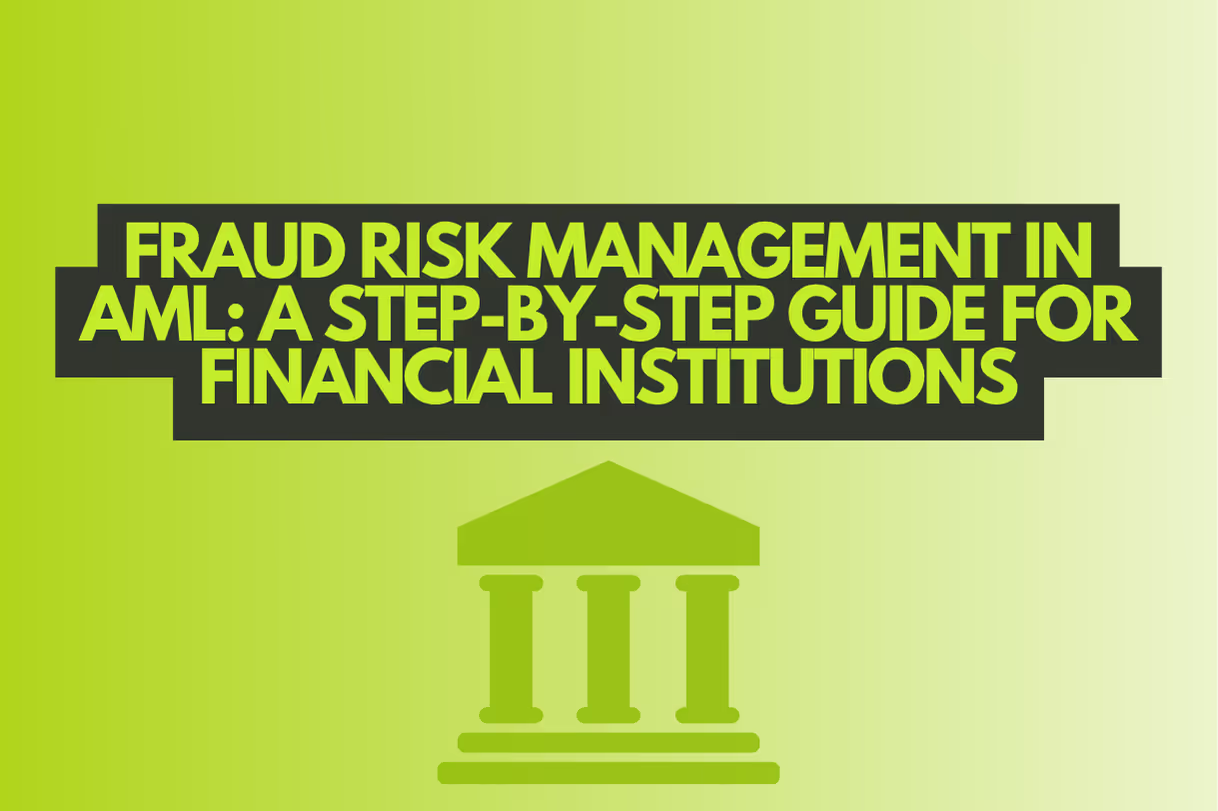
Fraud Risk Management in AML: A Step-by-Step Guide for Financial Institutions
Learn how to implement fraud risk management in AML. Understand controls, prevention methods, and compliance with anti-money laundering laws. Read the full guide.
Fraud management is complex and many businesses struggle to protect themselves and their clients against it. According to the Economic Crime Survey by PWC, 55% of companies reported procurement fraud as a concern in their country, while only a small minority stated that they were using tools to actively identify or combat it. 42% stated that they did not have a third-party risk management program, or did not conduct any form of risk scoring as part of their program.
Many financial institutions face rising pressure from regulators to detect, prevent, and respond to fraud proactively. But what does good fraud risk management look like - and how can your organization implement a scalable, compliant program?
In this guide, we’ll take you step-by-step through the essential building blocks of fraud risk management in AML. From governance and risk assessments to internal controls and suspicious activity reporting, we’ll help you build a program that not only protects your business but also meets evolving regulatory expectations.
What Is Fraud Risk Management in AML?
Fraud risk management refers to the strategies, controls, and processes put in place by a financial institution to identify, assess, and mitigate the risk of fraudulent activities, especially those that intersect with money laundering or terrorism financing.
Unlike general operational risk, fraud risk directly involves intentional deception for unlawful gain. When these risks go undetected, they can lead to regulatory breaches, reputational damage, and significant financial losses.
In the AML context, fraud often overlaps with:
- Identity theft and synthetic identities
- Account takeover fraud
- Transaction fraud
- Internal or collusive fraud
- Shell company misuse
- Money mule schemes
To manage these risks effectively, institutions must incorporate fraud detection and mitigation as a key pillar of their AML compliance program.
{{snippets-case}}
Why Fraud Risk Management Is Essential for AML Compliance
1. Regulatory Expectations
Authorities like FinCEN, FATF, FCA, and the European Banking Authority (EBA) all emphasize the need for financial institutions to detect and prevent fraud within their AML programs.
In fact, under AML regulations, firms are expected to:
- Monitor for unusual activity that may involve fraud
- Investigate and report suspicious transactions
- Maintain adequate risk assessments that include fraud typologies
2. Customer Due Diligence (CDD) Dependencies
Effective fraud risk management is also tightly linked to Customer Due Diligence (CDD). Verifying the identity and risk profile of a customer at onboarding (and throughout the customer lifecycle) is essential for both fraud and money laundering prevention. For high-risk customers, Enhanced Due Diligence (EDD) procedures become even more crucial. (Read more about EDD vs CDD in Financial Compliance).
3. Operational Risk and Business Impact
Financial fraud doesn’t just affect compliance; it can also trigger direct operational disruptions. Fraudulent activities can lead to chargebacks, customer attrition, internal investigations, and even insurance claims.
By embedding fraud management in your AML framework, you can reduce both financial losses and compliance exposure.
Step-by-Step Fraud Risk Management Process
Let’s break down a robust fraud risk management program into six practical steps:
Step 1: Establish a Governance Framework
Fraud risk management must start with strong governance and organizational oversight.
Key Actions:
- Assign clear responsibilities across the Three Lines of Defense:
- 1st Line: Business and operations teams are responsible for detecting, escalating, and managing potential red flags as part of their day-to-day activities.
- 2nd Line: Compliance and risk functions design and implement fraud controls, monitor their effectiveness, and provide oversight to ensure risks are managed appropriately.
- 3rd Line: Internal audit provides an independent and objective assessment of the fraud risk management framework, evaluating the design and effectiveness of controls across the organization.
- Appoint a fraud risk officer or designate AML team members to oversee fraud risks.
- Create a fraud risk policy approved by the board or senior leadership.
- Ensure senior management sets the tone for a zero-tolerance fraud culture.
You can read more about AML-CFT Compliance Programs: The Three of Defense on our blog.
Step 2: Conduct a Fraud Risk Assessment
A tailored fraud risk assessment identifies where your institution is vulnerable and what controls are needed.
Key Actions:
- Map your products, services, customers, and delivery channels.
- Use internal data and external typologies (e.g., FATF reports) to identify likely fraud schemes.
- Assess inherent risk vs residual risk based on your control environment.
- Prioritize high-risk areas, such as digital onboarding, cross-border payments, or correspondent banking relationships.
Step 3: Implement Risk-Based Controls
Effective fraud controls must match the risk level of different products and services.
Key Fraud Control Categories:
- Preventive controls: KYC verification, biometric authentication, device fingerprinting
- Detective controls: Transaction monitoring, behavioral analytics, anomaly detection
- Corrective controls: Account freezing, transaction blocking, customer offboarding
Don’t forget to link these to your AML transaction monitoring rules, ensuring coverage of fraud-related red flags.
Step 4: Integrate Anti-Fraud Measures in AML Processes
Avoid siloed risk management. Fraud risk must be embedded in core AML workflows:
- Include fraud indicators in customer risk scoring.
- Monitor for fraud patterns as part of your AML alerts.
- Flag unusual transaction behavior that could indicate both fraud and money laundering (e.g., round-dollar transfers, transaction bursts, multiple accounts).
- Train staff to recognize fraud-linked red flags during onboarding and ongoing due diligence.
Step 5: Investigate and Report Suspicious Activity
Both fraud and money laundering suspicions should be escalated through a unified workflow.
Key Actions:
- Define escalation triggers for fraud-like activity in your case management system.
- Enable cross-functional investigations between AML and fraud teams.
- Where fraud is suspected, file Suspicious Activity Reports (SARs) to regulators such as FinCEN or national FIUs.
- Retain documentation of investigations to meet audit and regulatory standards.
Step 6: Monitor, Review, and Improve
Fraud typologies evolve constantly. Your fraud risk management program must adapt.
Key Actions:
- Perform annual or bi-annual fraud risk reviews.
- Update your risk assessment with new fraud schemes.
- Conduct post-mortems on fraud incidents.
- Leverage emerging technology, such as AI-based behavioral models or machine learning, to improve detection.
Examples of Common Fraud Risks in AML
Fraud and AML are closely interconnected, and financial institutions must be able to detect and mitigate various types of fraudulent activity that can facilitate money laundering. Below are several real-world examples that highlight the overlap:
- Synthetic Identity Fraud: In this scheme, criminals create fictitious identities by combining real and fake information—such as a legitimate social security number with a false name. These synthetic identities are used to open accounts, build credit, and eventually channel illicit funds through otherwise legitimate financial products. Once established, these accounts can be used to layer and integrate criminal proceeds, making detection more difficult.
- Romance Scams: Fraudsters often exploit individuals through online romance scams, where victims are manipulated into sending or receiving money on behalf of the criminal. Unknowingly, these victims act as money mules, moving illicit funds through their personal bank accounts. From an AML perspective, this presents a red flag for suspicious transactions and potential structuring.
- Internal Fraud: Employees within a financial institution may exploit their access or authority to override controls, falsify records, or collude with external parties. Internal fraud can be especially damaging because it bypasses standard monitoring systems and enables clients to evade AML checks. Effective internal controls and staff screening are essential to mitigate this risk.
- Phishing and Credential Theft: Criminals often use phishing emails or fake websites to obtain login credentials from customers. Once they gain access, they conduct unauthorized transactions or account takeovers, often structuring the transactions to avoid detection. These activities can be used to launder stolen funds and may go unnoticed without strong behavioral analytics.
- False Documentation: Fraudsters frequently use forged or manipulated documents to pass Know Your Customer (KYC) procedures. These documents may include fake IDs, proof of address, or business registration papers. Once onboarding is complete, these accounts can be used to move large sums of money across borders, potentially bypassing sanctions or AML restrictions.
Technology in Fraud Risk Management
Modern AML compliance programs are increasingly reliant on advanced technologies to detect and prevent fraud. These tools enhance traditional rule-based systems with intelligent insights, helping financial institutions stay ahead of evolving threats. Below are key technologies driving innovation in fraud risk management:
- Artificial Intelligence and Machine Learning: AI and ML algorithms analyze large volumes of transactional and behavioral data to identify patterns indicative of fraud. These technologies can detect subtle anomalies or correlations that traditional rules might miss, such as an unusual sequence of account activity or time-based behavioral changes.
- Device Analytics: By collecting data on the devices used to access accounts—such as IP addresses, browser configurations, or mobile device IDs—institutions can identify risky or suspicious behavior. For example, if a user logs in from a known device and then suddenly switches to a device from a high-risk country, this may trigger a fraud alert.
- Graph Analytics: Graph technology allows institutions to map relationships between entities such as accounts, transactions, individuals, and devices. This can reveal hidden connections between fraudsters operating within a network and uncover fraudulent ecosystems that might otherwise remain undetected.
- Geolocation Tools: Tracking the geographic origin of logins or transactions can help detect suspicious activity. For example, a customer based in the UK who logs in from a country on a sanctions list or performs transactions across multiple countries in a short time may raise red flags for both fraud and AML violations.
When selecting an AML solution, financial institutions should prioritize platforms that offer integrated fraud and AML detection capabilities. Look for systems that allow configurable rules, generate real-time alerts, and support efficient case management workflows. The ability to combine fraud prevention and AML compliance into a single interface not only improves detection but also ensures faster response times and better audit trails.
{{snippets-guide}}
Key Takeaways for Compliance Teams
- Fraud and AML risk are converging. A unified strategy increases both effectiveness and efficiency.
- Fraud prevention is not just about technology—it requires a strong culture, governance, and process alignment.
- Regulators expect fraud risks to be identified, assessed, and documented within your AML risk framework.
- Ongoing monitoring, training, and review are essential to staying ahead of fraud evolution.
- Make use of internal frameworks like the Three Lines of Defense to assign responsibility and create accountability.
Final Thoughts: Fraud Risk Management in AML
Fraud risk management is no longer optional—it’s essential to surviving and thriving in a complex regulatory landscape. Financial institutions must take a proactive, integrated, and data-driven approach to fraud within their anti-money laundering compliance efforts.
At sanctions.io, we’re committed to helping compliance professionals stay ahead of risk with smart, scalable tools and best practices.
Looking to improve your fraud detection workflows? Contact us for a personalized walkthrough of how our platform can support your compliance goals.



